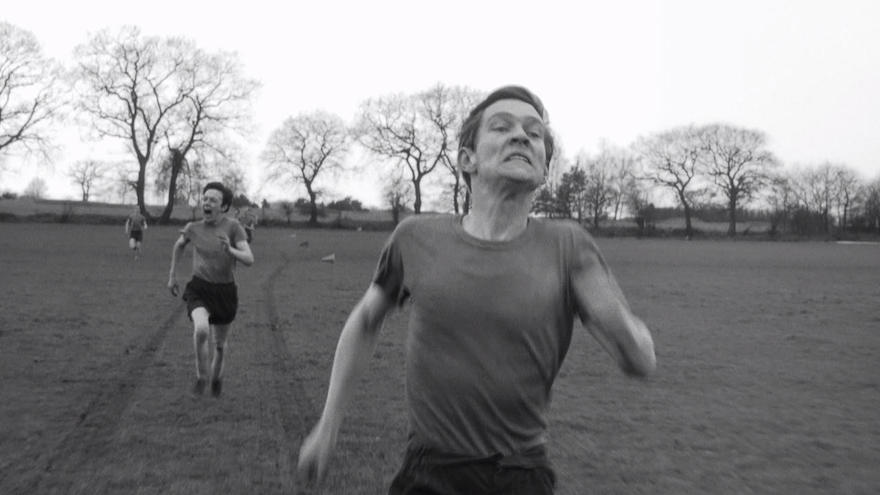If you haven’t heard of Jonathan Sutak, producer and director of The Foreigner, a new documentary about professional StarCraft II (2010), you can take solace in knowing that you’ve probably seen some of his work. Not, mind you, the two independent dramas—Up The River (2015), a romance, and Don’t Worry Baby (2015), a comedy—he’s produced; you haven’t seen those. What you have seen are the many trailers and TV spots he’s edited, for films as far afield as Everest (2015) and Kingsman: The Secret Service (2015). If not exactly a Hollywood insider, Sutak nevertheless approaches filmmaking from the perspective of someone who operates in the conventions of popular film. For this reason, Sutak bristles at the suggestion that The Foreigner is an ‘esports documentary.’ What it really is, in his words, is a ‘documentary about esports.’
Semantics? Perhaps. But, for Sutak at least, this distinction is significant. As he explains, it situates the director of a documentary in relation to its subject. Sutak insists that, despite being a ‘fan’ of esports, he has never been “part of the esports community . . . because [he] wanted to remain objective while documenting it.” The Foreigner, in other words, is the creation of a documentarian interested in esports, not an esports fan interested in documentaries. Whether or not you find it convincing, Sutak’s statement takes on particular importance at a moment when esports seems to be shedding its subcultural insularity. With esports popping up in more and more places—even démodé Yahoo! has launched an esports division—it’s worth questioning where and why the boundary Sutak alludes to is drawn. What is ‘in’, what is ‘out’? What does it even mean to be ‘in’ or ‘out’? What’s the difference between an esports documentary and a documentary about esports, and does that difference really matter?
As it turns out, The Foreigner, and its place in the surprisingly robust canon of esports documentaries, presents an ideal opportunity to ruminate on these questions. Conservatively, since 2000, directors both professional and amateur have produced over 70 esports documentaries of widely varying length and quality. Taken together, they exhibit a tremendous diversity of approaches, audiences, and attitudes. At a brief 22 minutes, The Foreigner is Sutak’s small contribution to this tradition. Yet it is, I propose, also among the most significant. That’s not to say that it’s either the ‘best’ or most ‘well-produced.’ Too often, we take quality and significance to be synonymous, a critical elision that can blind us to films whose importance is not immediately obvious.
Given its running time and that it was produced by someone best known for editing film trailers, The Foreigner might be dismissed out of hand on account of its lack of cinematic braggadocio, especially when compared to slick productions like Valve Corporation’s Dota 2 documentary, Free to Play (2013). But despite its brevity, The Foreigner provokes intense reflection on esports as a cultural phenomenon, as well as its histories, audiences, and place in culture at large. What’s more, The Foreigner is an object lesson in esports’ near-Oedipal obsession with being seen as ‘legitimate,’ the way that ‘real’ sports are. Freudian drama aside, what’s so crucial about The Foreigner is not simply that it confirms the importance of esports—hardly a radical claim in 2016. It’s that The Foreigner sheds light on the more challenging, but more rewarding, question of how and why esports has achieved its importance.

But it takes a long lens to see why. Though competitive videogame playing stretches back into the early 1970s—competitive Spacewar! (1962) was a counterculture favorite in the Bay Area—‘esports’ is a comparatively recent phenomenon. The term first appears in a 1999 press release announcing the ill-fated Online Gaming Association, an early (and naïve) attempt to establish a regulatory body for professional gaming. ‘Esports,’ in this sense, is distinct from the wider field of competitive gaming through the conscious emulation of professional sports, its institutions, and its conventions. As any baseball junkie will tell you, knowing the MLB rulebook isn’t even half of being a ‘baseball’ fan. ‘Baseball,’ the cultural entity, is simply incomplete without speculation over absurd contracts, shifting rivalries, jurisprudential misadventures in the off-season, franchise mythologies, and the pleasures/perils of increasingly outrageous stadium food. ‘Sports,’ in other words, is more than the sum of its games. It’s a culture, and should be analyzed as such.
So too with esports. If we really want to understand ‘esports’ as an institution, it’s therefore essential to consider all the practices and conventions that make up ‘esports’ beyond the rules of a particular game. Perhaps the surest sign of esports’ financial and cultural stability is the establishment of what might be called secondary industries. Massive prize pools and television broadcasts of esports have, in fact, been around since the mid 2000s: USA Networks began broadcasting professional Halo in 2006, while the 2005 Cyber Professional League boasted a $500,000 purse. What’s more telling about the esports of 2016 is the proliferation of esports production companies, online betting services, stat databases, strategy sites, and news outlets. ‘Homegrown’ versions of these have been around for at least a decade, but recent investments in esports by established companies with no prior interest in esports—including ESPN, The Score, Turner, etc.—are premised upon the stability and lasting success of esports.
Alongside and in relation to this story of spasmodic growth and contraction emerged the esports documentary. Tracing the history of these films, as it turns out, reveals a lot about the history of esports as a whole. As a general rule, esports documentaries have been released in three waves that correspond, roughly, with three moments of increasing visibility for esports: the mid 2000s, the early 2010s, and the present day. In 2005, for example, when esports began to connect with a wide audience outside of East Asia, National Geographic filmed a vaguely ethnographic documentary, StarCraft: World Cyber Games, at the titular tournament. Later that year, MTV profiled professional Super Smash Bros. Melee (2001) player Ken Hoang for its series True Life. In the early 2010s, as League of Legends (2009) and StarCraft II (2010) saw explosive growth in popularity (League viewership increased more than 700% between 2011 and 2012), a new cluster of documentaries were pushed out, many of which were funded by the up-and-coming crowdfunding platform of the time, Kickstarter. And, finally, since early 2015, many ‘mainstream’ outlets have been publishing a stream of documentaries ostensibly about the ‘sudden arrival’ of esports.
The Foreigner, which was officially released in 2015 but only recently became publicly available due to film award season schedules, belongs to the most recent wave of esports documentaries, but has its origins in that of the early 2010s. Sutak first conceived of what would eventually become The Foreigner when he noticed that YouTube videos of professional StarCraft II matches received hundreds of thousands of views within hours of being uploaded. Eager to get involved, but well-aware that playing competitively was out of the question, Sutak decided that he could put his talents as a filmmaker to use by documenting the growing Western scene. Such a film would capture a frenzied, nascent moment in the history of esports for future generations: “I felt I had a responsibility to frame [StarCraft II] in a compelling way—not just for the sake of art or entertainment, but as a historical document.”

Though Sutak originally envisioned making a feature-length documentary (a now-abandoned project called My Life for Aiur; its announcement is still visible on the popular StarCraft forum, TeamLiquid.net), he was ultimately dissuaded from doing so, in part, by the release of nearly a half-dozen longform documentaries about professional StarCraft II between 2011 and 2013. By and large, these documentaries, though well-intentioned, bear the telltale signs of projects with more directorial ambition than talent. The bloated Sons of StarCraft (2013) was meant to chronicle the career of the legendary casting duo, Nick ‘Tasteless’ Plott and Dan ‘Artosis’ Stemkoski, but is best remembered for the allegations of fraud and directorial mismanagement that plagued its production. Likewise, forum-turned-sponsor Team Liquid’s highly-anticipated Liquid Rising (2012) was billed as a comprehensive history of the organization, the ‘heart’ of Western StarCraft II, but ultimately took the form of a series of interviews with exactly zero narrative coherence; lots of words, with little sense of why they matter. Several documentaries from this period never yielded a finished product. Star Nation, intended to be a survey of StarCraft II in America, despite raising nearly $25,000 on Kickstarter, has never been released (and, presumably, never will be). Though there was no shortage of enthusiasm—and therefore crowdfunding—for documentaries about StarCraft II in the early 2010s, virtually every film produced fell flat on account of hasty production, overestimation of artistic ability, financial boondoggles, or some combination thereof.
By contrast, The Foreigner, a personal project pursued as a complement to Sutak’s more remunerative business of editing trailers, was unburdened by a pressure for quick release and the cries of impatient Kickstarter backers. Sutak also shows a judicious sense of directorial restraint that’s desperately lacking in so many other StarCraft documentaries. Though Sutak collected footage for The Foreigner at eight major tournaments, he ultimately scaled back his original, macroscopic intentions for the project in order to focus on a single, potent episode in the mythology of professional StarCraft II: MLG Columbus 2011, the first tournament in which South Korean players competed against ‘foreign’ (i.e. non-Korean) ones outside of Korea. The tournament is remembered as something of a Waterloo for ‘foreign’ StarCraft II. Though South Korea was the unquestioned champion of StarCraft: Brood War (1998), many in North America and Europe hoped that foreign players would rise to the level of Koreans in StarCraft II. MLG Columbus 2011, where the Koreans outclassed foreigners in every way imaginable, put an end to that. Since then, foreign players have won only a handful of premier tournaments (to wit, of the 20 winningest StarCraft II players, only one, Ilyes ‘Stephano’ Satouri, is not Korean).
Sutak examines MLG Columbus 2011 through the eyes of his titular foreigner, Greg Fields, known more widely by his nom de guerre, ‘IdrA.’ Even before his scandalous retirement from competitive play in 2013, IdrA’s tumultuous career was the stuff of legends. Briefly: after his 18th birthday, IdrA famously moved to South Korea to live and train with professional StarCraft: Brood War players. Though he experienced limited success in South Korea, he was, by a wide margin, the strongest foreigner in Brood War, which foreshadowed his initial success in StarCraft II. But what really captured fans’ imagination about IdrA was his notorious pugnacity, which elevated him from talented competitor to esports icon. IdrA eschewed the principles of good sportsmanship and professional decorum; handshakes were refused, opponents insulted, and keyboards smashed. Over time, IdrA’s antics overshadowed his achievements as a player, and he gained a reputation for being technically gifted, but emotionally vulnerable.
In the early days of StarCraft II, South Koreans rarely ventured beyond their border. Yet increasing competition in Korea, paired with the promise of tournaments abroad stocked with inferior players, meant that Korean pros quickly set their sights on world wide dominance. MLG Columbus was, officially, at least, the beachhead of the Korean invasion (née the Global StarCraft League – Major League Gaming Exchange Program) in North America. At the time, IdrA, then at the peak of his skill, was thought to be the only foreign player capable of halting its advance. The Foreigner picks up with a truncated version of this general story and follows IdrA as he works his way through the group stages of MLG Columbus and into the playoff bracket. Longtime fans of StarCraft II know what’s coming: the dramatic climax of The Foreigner constitutes one of the most notorious moments in StarCraft II history. In a crucial match against Mun ‘MMA’ Seong Won, IdrA inexplicably quits a game he had all but won. Sutak perfectly captures the moment through a series of reaction shots: MMA giggles in his booth, shocked by his good fortune; the casters’ jaws have, quite literally, dropped; the audience stares in silent disbelief, their illusion that foreigners would usurp their Korean overlords shattered. Then, Sutak turns the camera on IdrA himself, who simply stares into the screen with an expression of straight-faced inscrutability.

It’s a challenging moment to depict, but Sutak handles it with grace. For Sutak, the episode is reminiscent of Alan Sillitoe’s 1959 short story, ‘The Loneliness of the Long Distance Runner,’ in which the protagonist, an inmate in a juvenile detention facility, is offered the chance to shorten his sentence by winning a long distance foot race organized by the wardens. Though he easily outruns his opponents, he deliberately stops short of the finish line as a declaration of his independence. The parallels to IdrA’s abdication in Columbus are obvious, but they raise a number of questions about the meaning of the abdications. Was IdrA’s forfeiture a gesture of vanity or hubris in the extreme? Perhaps he misread the battle and genuinely believed that he had lost. Were IdrA’s actions, like Smith’s refusal to submit to his captors’ contest, a kind of resistance to his commodification? Or maybe the pressure, that weight of Atlantean expectation that IdrA was asked to carry in Columbus, was too much to bear. In the delirious moments after IdrA quits, The Foreigner refuses to settle this ambiguity. A lesser director might have pestered IdrA for an explanation, but Sutak allows the viewer to draw their own conclusions about this curious vignette. As if to underscore this open-endedness, Sutak juxtaposes the credits over a close up of IdrA’s emotionless expression.
It’s a thoughtful close to a well-crafted film, which is in itself enough to secure The Foreigner the reputation of being the best StarCraft II documentary to date, even if the competition isn’t very stiff. But ‘good’ isn’t the same as ‘important,’ and The Foreigner is both. To think about why the film is important, it’s not enough to ask simply what it means, but also what it does. So while we could and probably should debate the ‘meaning’ of IdrA’s actions at MLG Columbus, and reflect on whether or not The Loneliness of the Long Distance Runner is a useful precedent for coming to terms with this loss, it’s equally important for us to ask what effects The Foreigner has upon its subject, and upon its audiences.
In 1987, the film theorist Bill Nichols wrote that the documentary is, all at once, “a filmmaking practice, a cinematic tradition, and a mode of audience reception.” There are many potential effects for a successful documentary—it can praise, criticize, or raise awareness in a general sense—but, in one way or another, documentaries lend an air of ‘legitimacy’ to their subjects. One way of interpreting the surprisingly large number of esports documentaries is that esports communities desperately want to be seen as legitimate, and, as a result, were eager to bankroll just about any attempt at making a documentary. The logic here is that every documentary, by virtue of its existence, establishes its subject as ‘worthy’ of documentation. The inverse holds true as well: documentaries are legitimated by their subjects, the perceived worth of which justifies the documentary itself.
It’s a strange, symbiotic relationship, but it would be a mistake to assume that the correspondence between a documentary and its subject is either simple, transparent, or automatic. Words like ‘legitimate’ always smuggle with them the thorny, unsaid question ‘legitimate to whom?’ Such judgements must be situated in the context of a particular audience. The viewer, philosophy of aesthetics be damned, is never an abstract ideal but a particular human being who belongs to particular communities, and consumes media through the lens of a preexisting set of interests and biases. Identity is not something we think ‘about’ so much it is something we think ‘with.’ To understand how and why esports documentaries, from MTV True Life to The Foreigner, do or don’t legitimize ‘esports’, it’s essential to examine these films’ intended audiences and the modes of address they employ to engage those audiences.

A still from the 1962 film version of The Loneliness of the Long Distance Runner
At its heart, this is a question of what counts as being ‘in’ and ‘out’ of esports. Making these assumptions implicitly constructs a knowledge-boundary about what esports fans know, and what those not interested in esports presumably don’t know. What’s useful about uncovering this boundary is that it allows us to imagine the audience for esports as something more nuanced than a growing horde of unspecified individuals. Instead, we can see how specific documentaries address (or not) particular audiences by unpacking the assumptions a film makes about what the viewer does or doesn’t know. Two intransigent formal conventions of esports documentaries are particularly telling: one, the manner in which a documentary introduces ‘esports’ as a whole, and, two, how a documentary explains the mechanics of whatever game is being featured.
On the first point, many documentaries about esports devote the first few minutes of their running time to a general introduction to esports as a whole. Typically, this includes long shots of stadiums bathed in dark light, slow pans over cheering crowds, infographics of exponentially growing esports prize pools or viewership, all carefully selected and arranged to convince the viewer that esports is serious business. Unsurprisingly, this kind of exposition-as-justification generally indicates that the intended audience is not one already familiar with esports (i.e. ‘outside’ esports). Why else would these viewers need to be convinced that the documentary is worth their time? ESPN’s short documentary Throne of Games, which examines the North American Dota 2 team’s victory at The International 5, the largest esports tournament in history, is a prime example. Advertised as “an unprecedented look into the world of professional video games,” the film draws upon familiar narrative contours—young men whose parents don’t approve of their passions but go on to win absurd amounts of money—and visual motifs—Evil Geniuses walks onto the stage of Seattle’s KeyArena through a haze of photogenic fog—to persuade skeptical viewers that esports might be worth their time (and, to connect esports to ESPN’s more traditional program; ESPN launched its own esports division only a few months after broadcasting Throne of Games).
Often, documentaries of this sort represent a kind of double-edged sword for esports. Attempts at introducing esports to viewers who aren’t aware of or amenable to its existence often end up reinforcing esports’ alterity. Esports, in this sense, is presented as a curious spectacle, possibly admirable, possibly lamentable, but definitely different. Especially in the first wave of esports documentaries (~2005-2007), the exposition portion of esports documentaries evinces a tone of bemused novelty, if not outright condescension. The entire premise of the MTV True Life profile of Ken Hoang et al, of course, is that playing videogames for a career is too absurd to be ‘true life.’ In all cases, the documentarian is thus established as an outsider looking in—what Sutak would call a ‘documentary about esports.’ As a result, the boundary between what’s ‘in’ and what’s ‘out’ is made more, not less, rigid.

The other telling convention is the degree to which an esports documentary explains the mechanics of whatever game is being played, a task that’s easier in some cases than others. StarCraft, in which battles are fought by color-coded armies and follow the general principle of ‘the side with the biggest army is ahead,’ is surprisingly legible for the uninitiated. When a fortification of siege tanks and marines is overrun by a swarm of insectoids, it’s obvious which faction is winning. Likewise, most fighting games—Street Fighter, Mortal Kombat, Super Smash Bros., etc.—place a relatively low burden of knowledge on the viewer. The subtleties of a bout might escape neophytes, but it’s clear that the character getting their ass beat is losing. By contrast, the cataclysmic, frenetic teamfights of Dota 2 and League of Legends are nigh-unintelligible to unseasoned viewers. So impenetrable is Dota 2 to newcomers that, at Dota 2’s premiere tournament, The International, Valve sponsors a stream dedicated solely to a cast directed at those not familiar with the game and its mechanics.
Traditionally, whether or not a documentary feels the need to explain the basics of a given esport says a lot about who the documentary assumes its audience is. Valve’s Free to Play, for example, devotes nearly 10 minutes—a significant investment of time for a film that’s barely longer than an hour—to an explanation of the basics of Dota 2’s ruleset to viewers. Throughout the lesson, Dota 2 personalities make repeated allusions to widely-known reference points (e.g. “Dota 2 is played five on five, like basketball”), leaving little doubt that Free to Play is as much intended for audiences who don’t play Dota 2 as much as it is for those who do. In this respect, Free to Play is a particularly well-made advertisement for Dota 2. This doesn’t necessarily undercut its artistic value, but it does speak to its authors’ intentions.
There are, of course, other telling signs about address and audience. One of the most famous esports documentaries is The Smash Brothers (2013), the Super Smash Bros Melee community’s love letter addressed to itself. Produced on a budget of $12,000 raised through Kickstarter, the documentary’s production coincided with professional Melee’s long winter, when prize pools dried up and most of the first wave of professional players retired in obscurity. As a result, an eulogistic air infuses much of the film. What The Smash Brothers lacks in production value it more than makes up for in its spirit. Still, at a cumbersome four hours and 18 minutes, it’s hard to imagine anyone without a preexisting interest in Super Smash Bros. committing to a complete viewing. Likewise, the crass language of the players wouldn’t alarm many of those in the late 2000s Super Smash Bros. scene, but would do little to endear the game and its culture to someone who wasn’t at least familiar with the community’s discursive conventions. The point isn’t to be judgemental, but to note that a documentary truly intended for a wide audience would have, firstly, been much shorter and, secondly, selectively edited some players’ coarser comments, especially the frequent allusions to ‘raping’ their opponents.
The Foreigner, though, is an outlier among esports documentary films in that, excepting some quotes made in passing, it devotes almost none of its running time either to introducing esports in general or explaining what transpires in a game of StarCraft II. Does this mean that Sutak is operating on the assumption that his viewers are familiar with esports? Not quite. Sutak includes many shots of in-game footage—flocks of Mutalisks tearing through a cluster of prefab buildings, marines being swarmed by goo-spewing Banelings etc.—but he seems distinctly less interested in their narrative value than in the kinetic sense of action they convey. Someone familiar with IdrA’s series against MMA might in fact recognize some specific moments (including MMA’s infamous and unintentional destruction of his own Command Center), but even a viewer with no knowledge of StarCraft II can appreciate these shots’ aesthetic value; paired with quick cuts, they lend The Foreigner a frenzied pacing that mirrors what a seasoned StarCraft II viewer gets from watching a competitive match. There is, in short, something—but something different—for both kinds of audiences, which presents a certain difficulty for the question of address, and, by extension, Sutak’s own distinction between esports documentaries and documentaries about esports.

A still from The Smash Brothers
Likewise, Sutak trusts that viewers need not see an infographic about prize pools and viewership to recognize the human story that animates The Foreigner. At the same time, MLG Columbus 2011 represents something very specific to fans of StarCraft II; it was a bright point in the game’s early arcadian history that made palpable the dream of esports as something other than a subcultural curiosity. Amid the broadcasts, the neon lights, the screams, the cheers, the sponsors, and, most of all, the thought that we foreigners might beat the Koreans at their own game, there was an electric sense that something about esports had changed irreparably. Unlike the junkyard of unrealized dreams in our collective past, this time, esports was here to stay. Sutak was there, and so I’m sure he witnessed this, but that’s not the same as knowing if he felt it—on that count, I have no idea. But this multiform feeling pervaded every attendee of MLG Columbus, who hung on StarCraft II their hopes for a future for (and of) esports. I should know; I was watching too.
For a moment, let me drop the dispassionate tone of a critic and speak as someone who has loved esports for a decade and is now a part of the industry, largely because of StarCraft II’s success. There’s no point in pretending I don’t have a stake in esports; in fact, for four years, I’ve worked with the same organization that sponsored IdrA at MLG Columbus, Evil Geniuses. I am, in short, anything but an impartial observer (so consider this my disclaimer and disclosure). Like Sutak, and like IdrA, I began playing StarCraft in the early 2000s, and was both amazed and excited when I one day discovered that, on the other side of the world, some people did this for a living. As a consequence, StarCraft II, for me and for so many others, bore an unbearable weight of expectation. At long last, esports would take root in the West! A myopic perspective in retrospect, but sincerely held all the same. And so when StarCraft II was finally released in July of 2010 following a tortuous, prolonged development, I devoted to it a sum of hours so great I am embarrassed to reveal it.
In fact, it was over 2,000 hours, plus many more spent watching player streams, tournaments, and updating esports’ largest wiki, Liquipedia. When later I received the opportunity to work in esports, I seized it not simply because I wanted to be part of an emerging industry, but to prove to myself that all those hours had not been wasted. What I wanted, in other words, was for esports as an ‘institution’ to legitimize my passion to myself. But the truth about passions is that they do not require justification. Indeed, they cannot be justified—if they could be, why would we call them passions? When we construct elaborate, productive justifications for our passions, haven’t we surely missed the point? And this is, I propose, the strange paradox of legitimation: it is achieved at the exact moment we no longer feel the need to achieve it. This is, after all, the humor of the meme “We demand to be taken seriously”: anyone who demands to be taken seriously should under no circumstances be taken seriously. True legitimation involves seamless integration into the textures of everyday life.
This has been true for me, and, in my mind, it’s true for esports as a whole, which is what makes The Foreigner such a significant film, probably without trying to be. But, in a sense, isn’t that the point? With The Foreigner, Sutak found a human story—and a form to match it—that could speak to anyone willing to listen, be they a lover of esports or not. While ‘outsider’ directors have seen meaningful narratives in esports many times before, they were inevitably possessed by a need to frame those stories in an argument about the legitimacy of those stories (see: Throne of Games). What’s so important about The Foreigner is that although it was purportedly filmed from the ‘outside’ of esports, it displays no evidence of a compulsion to justify its subject. The worth of esports, like its legitimacy, is taken as axiomatic.

Likewise, Sutak uses familiar conventions, storylines, and archetypes to emphasize his subject’s commonality, not difference, with sports and culture as a whole. The point is not that esports have become like sports (or that sports have become like esports), but that they are becoming like each other. As it turns out, the solution to the perennial desire for ‘legitimacy’ was not to move the ‘inside’ of esports outwards, or to bring the ‘outside’ ‘in.’ Rather, it’s to avoid the temptation to make that distinction entirely, to refuse the Faustian bargain that simultaneously blesses esports with visibility and curses it with alterity. This, in my mind, is a genuine triumph, and, for now at least, The Foreigner is unique among esports documentaries in making this point about esports. So perhaps it’s unsurprising that Sutak has been well-rewarded for The Foreigner: it is the first film about esports to win any significant award from the discerning film festivals of the world, being named ‘Best Short Documentary’ at both the Las Vegas Film Festival and Los Angeles New Wave International Film Festival.
In the conclusion to his book How to Do Things With Videogames, Ian Bogost wonders aloud about the supposed and imminent end of ‘gamer’ as a useful identity. As he writes, ‘as videogames broaden in appeal, being a “gamer” will actually become less common, if being a gamer means consuming games as one’s primary media diet or identifying with videogames as part of a primary part of one’s identity.’ If we’re fortunate, Bogost says, the identity will dissolve altogether, simply melting into ‘people’ and ‘culture.’ The Foreigner is, perhaps, the best evidence we have that the beginnings of such a shift is now underway for esports. There will be more esports documentaries, and no doubt that some will still treat esports as a spectacle of digital difference. The better ones won’t, and indeed, will explore what happens when esports is no longer an oddity but the norm. In an age where commerce means e-commerce and dating means online dating, we shouldn’t be surprised that the difference between esports culture, sports culture, and culture as such is wearing very thin indeed. Dissolution is grace.
